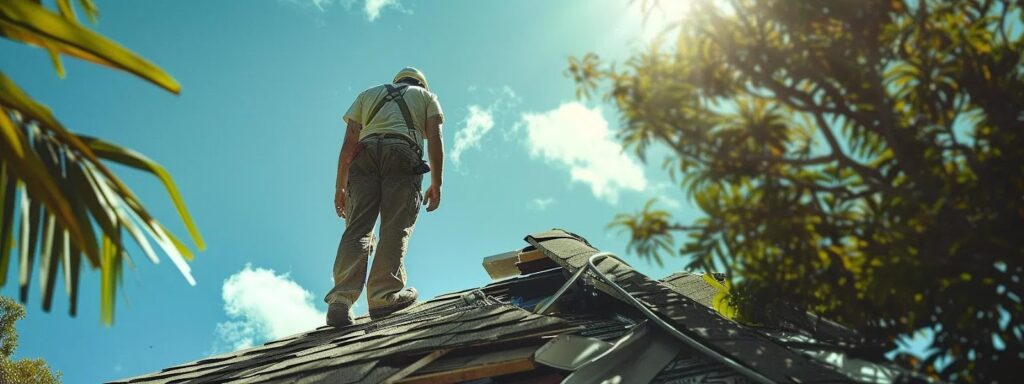A roof leak can happen at any time—especially after severe weather events like Hurricane Ian—putting your home at risk for further damage. This guide covers how to recognize the signs of an emergency roof leak, the immediate actions to take, and how to find prompt emergency roof repair services in Fort Myers so you can protect your home and avoid costly repairs.
Recognizing the Signs of an Emergency Roof Leak

Understanding early indicators helps you act fast and limit damage.
Identifying Common Indicators of Roof Damage
| Indicator | Description |
|---|---|
| Debris Accumulation | Leaves/branches trap moisture—common on flat roofs—leading to leaks. |
| Water Stains | Discoloration on ceilings or walls signals active or recurring leaks. |
| Cracked Flashing | Compromised metal at joints (vents, chimneys, valleys) allows water intrusion. |
| Missing Shingles | Exposes underlayment and decking; fast escalation to interior damage. |
How Fort Myers Weather Impacts Your Roof
| Weather Condition | Impact on Roof |
|---|---|
| Heavy Rain | Overwhelms drainage; accelerates leaks, especially on low-slope/flat roofs |
| High Winds | Lifts shingles/flashing, creating pathways for water |
| High Humidity | Promotes mold/mildew; weakens materials over time |
| Severe Storms | Immediate damage; often requires emergency response |
When to Seek Professional Help
-
Significant ceiling/wall staining or active dripping
-
Visible daylight through attic decking
-
Multiple missing/damaged shingles or torn membranes
-
Recurring leaks after “quick fixes”
Immediate Actions to Take When a Roof Leak Occurs
Prioritize safety, protect interiors, and stabilize the situation.
Ensure Safety Before Inspecting the Leak
-
Avoid standing water and slippery floors
-
Turn off electricity to affected areas if water is near outlets/fixtures
-
Do not climb on a wet or storm-damaged roof
Protect Your Home’s Interior From Damage
-
Place buckets/pans under drips; puncture ceiling bulges carefully to drain pooled water into a container
-
Move/cover furniture and valuables with plastic or tarps
-
Photograph everything for insurance (wide shots + close-ups)
Apply Temporary Fixes to Limit Water Intrusion
-
Tarp the affected area, extending past the ridge/valley; secure with boards/weights (not just tape)
-
For a small shingle failure, use roofing cement on the leading edge as a stopgap
-
Do not rely on spray foam as a primary exterior patch—it traps moisture
Then: call an emergency roofer for a proper assessment and repair.
Finding Prompt Emergency Roof Repair Services in Fort Myers
Locate Trusted Local Roofing Professionals
-
Look for storm-response experience and leak detection capability
-
Verify license/insurance; check recent local reviews and photo evidence of work
-
Ask about temporary protection (tarping/shrink wrap) and 24/7 availability
Share Essential Information With Your Roofer
-
Exact leak locations (rooms/ceiling spots), attic access notes
-
Roof type/age (shingle, metal, tile, flat/bitumen/TPO)
-
When the leak started, recent storms, and any prior repairs
-
Photos/videos and any safety hazards (electrical, ceiling sag)
Evaluate Estimates and Response Times
-
Prioritize rapid mobilization for active leaks
-
Request a written scope: temporary mitigation + permanent repair plan
-
Clarify warranties on both emergency dry-in and final fix
Understanding the Emergency Roof Repair Process
Typical Techniques Used in Urgent Repairs
-
Emergency dry-in: tarps, peel-and-stick underlayment, shrink wrap for large areas
-
Flashing resets/seals at chimneys, vents, skylights
-
Decking cut-out and patch where saturated/rotted
Materials Suited for Quick Fixes
-
Waterproof tarps, cap nails/boards, sandbags/weights
-
Roofing cement/compatible sealants (temporary)
-
Plywood for damaged areas until full repair
Addressing Fort Myers–Specific Challenges
-
High humidity: ensure assemblies can dry; avoid trapping moisture
-
Wind uplift: use correct fastening patterns and rated materials
-
Intense sun/UV: select UV-stable temporary membranes if delays are expected
Preventing Future Roof Leaks Through Maintenance
Schedule Regular Roof Inspections
-
Once per year and after major storms
-
Include attic check for stains, daylight, damp insulation
Implement Roof Care Best Practices
-
Clean gutters/downspouts; keep valleys and low-slope areas debris-free
-
Trim overhanging branches; confirm proper attic ventilation
-
Replace damaged shingles/tiles and reseal penetrations proactively
Upgrade to Durable, Climate-Appropriate Materials
-
Wind-rated shingles/fasteners, metal roofing, or high-quality tile systems
-
Corrosion-resistant flashing/fasteners for coastal exposure
-
Underlayments with superior water/UV resistance
Managing Insurance Claims for Roof Leak Damage
Document Damage for Insurance
-
Time-stamped photos/videos (exterior, interior, attic)
-
Keep receipts for tarps, mitigation, and emergency services
-
Maintain a log of dates, weather events, and communications
Navigate Your Homeowner’s Policy
-
Know deductibles, exclusions (wear/neglect), and temporary protection coverage
-
Ask about code upgrades and matching (materials/colors)
Coordinate With Adjusters and Roofers
-
Be present for inspections; have your roofer provide a scoped estimate
-
Align the insurer-approved scope with a durable, code-compliant repair
Conclusion
Fast action is everything: stay safe, protect interiors, stabilize with temporary measures, and bring in a qualified Fort Myers roofer quickly. Follow with thorough documentation and a durable, code-compliant repair tailored to our climate. With regular inspections and smart material choices, you’ll reduce future leak risk and keep your home protected year-round.






